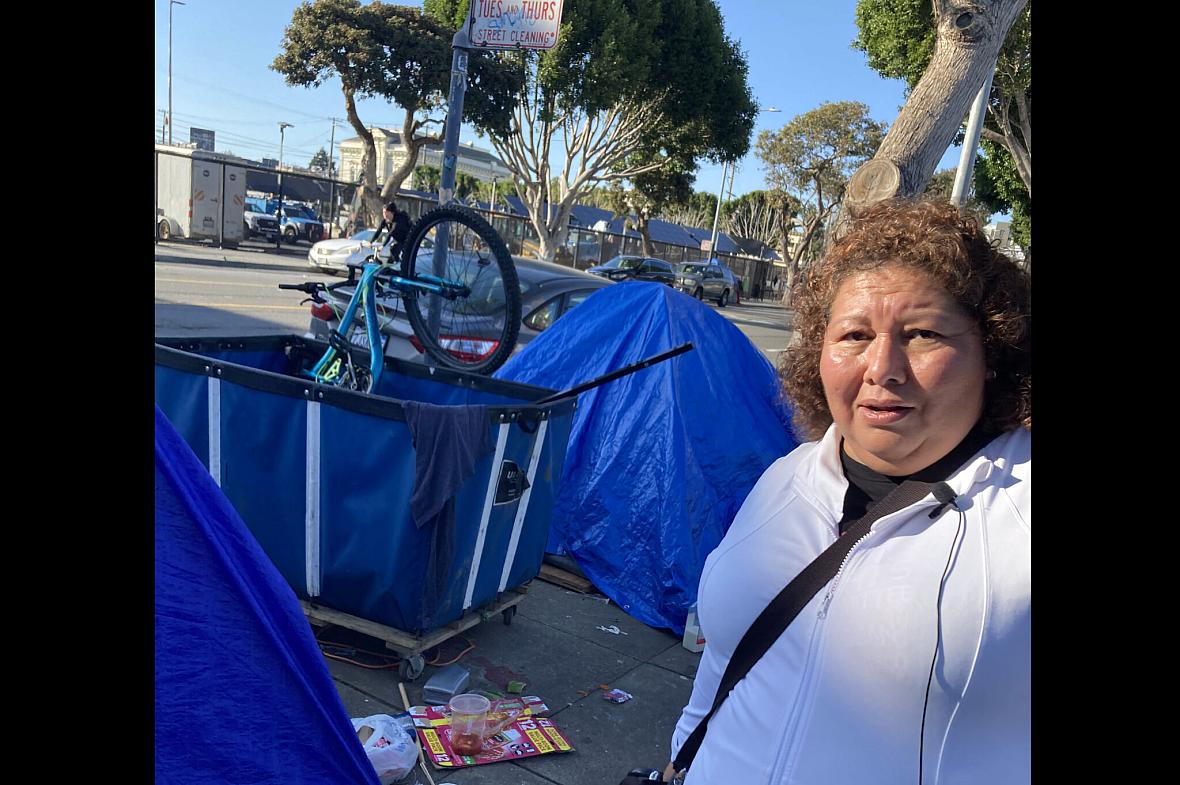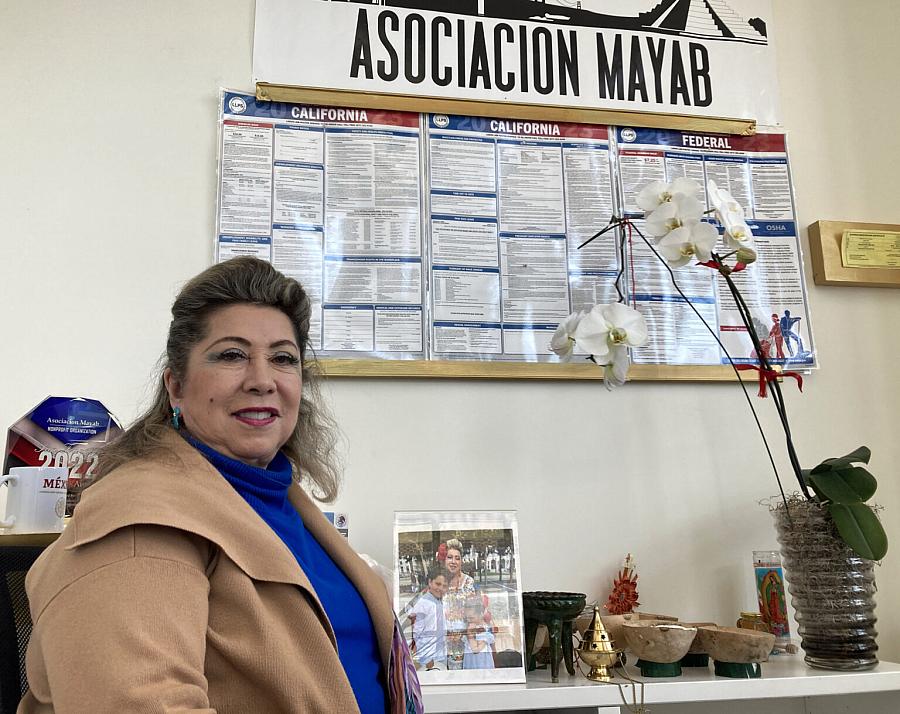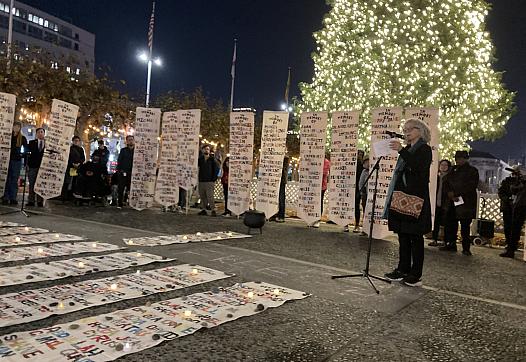Overdose Deaths Swell Among SF’s Maya Residents, Highlighting Urgent Need for Culturally Competent Drug Health Services
The story was originally published by San Francisco Public Press with support from our 2023 Data Fellowship.

San Francisco community ambassador Aurelia Ramirez walks along Folsom Street as part of her weekly circuit of the Mission District, where she engages with unhoused people while handing out coffee and informational pamphlets about local social services.
Sylvie Sturm/San Francisco Public Press
This article is adapted from an episode of the podcast “Civic.” Click the audio player below to hear the full story.
Every Saturday, Aurelia Ramirez fills a tote bag with pamphlets about local social support services, buys a few dozen slices of sweet bread and a box of brewed coffee, and walks through her Mission District neighborhood connecting with people living on the street.
“Our job is to check the people if they okay,” said Ramirez, who moved to San Francisco from Mexico 23 years ago.
Ramirez is a community ambassador for San Francisco’s Office of Civic Engagement and Immigrant Affairs. She said she wanted a job that allowed her to help the Latinx community — especially people of Maya descent from the Yucatán, like herself.
“It’s sad,” she said. “They don’t know what they can do. Especially Yucatán people.”
While offering coffee and snacks, she provides information about where to go for medical care, social services, shelter, showers and doing laundry. She said the pandemic caused deep suffering in her community and many never recovered.
“They lost a job, lost the house. They don’t have money. What they can do?” Ramirez said. “You know, people selling drugs — they give you free the first time but after, you need to pay. That’s the problem. And now some people, it’s not okay anymore.”
In fact, the rate of overdose deaths among Maya from the Yucatán living in San Francisco has risen enough since the COVID-19 pandemic to alarm San Francisco’s Mexican Consul General, Remedios Gomez Arnau, who processes death certificates of local Mexican nationals before they are repatriated.
On an unseasonably warm and sunny day in February, Ramirez roused people from their tents, and they appeared grateful for the coffee, snacks and information about when a free dental clinic would be open.
She urged Yucatecans to call their families back home from an office in Daly City called La Casa Del Yucateco that was launched by Yucatán Governor Mauricio Vila Dosal last October to provide Yucatecans in and around San Francisco with government advice and services.
Several unhoused people told Ramirez that what they needed most was housing and going into a shelter was out of the question because they feared violence and theft. Ramirez explained that even when people she encounters are interested in accessing resources, they confront obstacles.
“Sometimes they have wait lists — wait lists for shelter, wait lists for help,” Ramirez said. “And they don’t want to wait. They want the help at the same time.”
Seeking a Better Life
In Mexico’s Yucatán Peninsula, Indigenous Maya face systemic discrimination, limited access to education, health care and economic opportunities, and limited political representation.
The situation leads many to seek better opportunities elsewhere. And for generations, they have been immigrating to San Francisco and the Bay Area, according to Lydia Candila Chan, executive director of Asociacion Mayab, a San Francisco-based organization that offers cultural, educational and essential community resources.
Possibly as many as 70,000 Yucatec Maya live in and around the city, but there has never been an official count — it’s an estimate that Candila Chan gleaned from the Institute for the Development of Maya Culture based in Yucatán’s capital city, Mérida.
Candila Chan said Yucatec Maya come to San Francisco seeking financial opportunities “to give their families a better life.” But the language barrier can be a major hurdle to finding a job, since many speak Spanish as a second language and are not fluent. More than 500,000 Maya from the Yucatán speak the indigenous Maya language, according to the latest Mexican census.
Some Maya do achieve success, and for many, Candila Chan said, that’s thanks to their renowned culinary skills.
“They are the best cooks here in San Francisco,” she said. “Any restaurant that you go, you will see one person from Yucatan.”
The population’s extraordinary representation in restaurants made it exceptionally vulnerable during the pandemic, when the industry was shut down.
“The American dream sometimes become very sad for them,” Candila Chan said. “They became so disappointed that when friends say, ‘Let’s go drink a beer and talk,’ from that, they start more and more and more. Suddenly, they living in the street. Suddenly they die. I see so many.”

Lydia Candila Chan, executive director of Asociacion Mayab, develops culturally based activities and educational programs that promote the health and well-being of Indigenous Maya from the Yucatan living in San Francisco.
Sylvie Sturm / San Francisco Public Press
Lydia Candila Chan, executive director of Asociacion Mayab, develops culturally based activities and educational programs that promote the health and well-being of Indigenous Maya from the Yucatan living in San Francisco. Candila Chan does what she can to help by offering programs that provide essential resources as well as cultural activities that bring the community together in a healthy way.
More than 250 families benefit from the Asociacion Mayab’s weekly food pantry. The center also offers classes and performances of jarana, the traditional dance of Yucatán; arts and craft-making; Maya interpretation training; and an amateur baseball league that has grown to include eight teams and 144 players.
Indigenous Population Missing Fentanyl Warnings
Gomez Arnau, San Francisco’s Mexican Consul General, asked community partner Jorge Zepeda, director of Latinx health for the San Francisco AIDS Foundation, about the elevated rate of overdose deaths she was seeing among Indigenous Maya.
At the time, Zepeda was consulting with San Francisco’s Department of Public Health to assess the health of Latinx populations in single-room-occupancy buildings, commonly called SROs. He told Gomez Arnau he was seeing the same trend and he brought it up with the health department.
“I said, ‘Do you know how many people have died of overdose who are Spanish speaking and Maya speaking?’ They said, ‘Not sure,’” Zepeda said.
From January 2020 to last December, 2,955 people died of accidental overdose in San Francisco, according to the San Francisco Chief Medical Examiner’s Office. Of those, 456 were categorized as Latinx. But it’s impossible to get mortality rates of subgroups in the Latinx population since health authorities at city, state and federal agencies lump all Latin Americans together.
That neglects to account for the diversity of languages that exists within its subgroups, which means vital information, like warnings over the dangers of fentanyl and where to get help for substance use disorders, may not be reaching them.
Categorizing all Latin Americans together leads to other problems as well, according to advocates like Dr. Seciah Aquino, executive director of the Latino Coalition for a Healthy California, whose organization was part of a years-long campaign to get state departments to collect and disaggregate more detailed data for Latinx and Indigenous
communities.
“We’re not a monolith,” Aquino said. “We need to understand and receive data back that drills down to those specific subgroups. If we don’t, then we’re losing quality data that could lead us to make better decisions in terms of funding that’s being allocated to the community, regionally, how it’s being spread out.”
State Sen. Lena Gonzalez (D- Long Beach) introduced a demographic equity bill to strengthen state data collection last year. The Legislature passed the bill but Gov. Gavin Newsom vetoed it last October, saying it was inappropriate because the U.S. Office of Management and Budget was updating federal standards for collecting race and ethnicity information.
Updated federal standards announced on March 28 did not account for Indigenous Latinx populations. Gonzalez reintroduced her demographic equity bill on Feb. 27, and it is making its way through the state Senate.
Dire Need for Drug Awareness and Health Services
After discovering the gap in knowledge over Latinx and Indigenous drug use, Zepeda partnered with Laura Guzman, executive director of the National Harm Reduction Coalition, and Dr. Carlos Martinez, a public health and medical anthropology researcher from UC Santa Cruz, to conduct a study with funding from San Francisco’s Department of Public Health. The report of their study, “Unido/xs Contra La Sobredosis (United Against Overdose),” was published in September 2022.
They discovered that most Latinx and Indigenous people in San Francisco who consumed substances were trying to achieve a specific goal and had very little knowledge of risks associated with those substances.
“They knew the effect that they wanted, whether it’s keeping working, or relax, or going to sleep,” Zepeda said. “When we ask them, ‘Do you know the name of the drug?’ ‘No. But I can get it from a person that I know.’”
They concluded that to minimize overdoses and drug-related harm in the Latinx and Indigenous communities, the city must educate target populations on types of drugs, drug use impacts and awareness that drugs are often tainted with the opioid fentanyl, which can cause lethal overdose.
The study also revealed a glaring gap in the availability of treatment services. Zepeda said the majority of community-based providers serving the Latinx community “didn’t feel comfortable making a referral to a current substance use or substance health service providers in San Francisco because they were not in the capacity to engage with the Spanish-speaking or Maya-speaking communities.”
Zepeda said he’s seen some progress since the report came out — namely the public health department’s requests for proposals for behavioral health have recently included Spanish-speaking and Maya-speaking programs.
Department of Public Health officials declined requests for an interview. In an email, the department stated that it offers 10 beds in the Managed Alcohol Program for Latinx and
Indigenous patients. And it just launched an initiative called Health Access Point, which provides harm reduction services to Latinx clients through a program led by the Instituto Familiar de la Raza, the Mission Neighborhood Health Center and the San Francisco AIDS Foundation.
Also, the department anticipates that a planned, 33-bed expansion of a mental health and substance use treatment facility for women who have been arrested, charged, convicted or incarcerated will be Spanish-language competent.
Culturally Sensitive Programs Needed
Service providers say language competency is not the same as culturally sensitive programs, however, and those are nearly impossible to find for Latinx communities. The Latino Commission is the only organization providing that kind of residential treatment in San Francisco — and it only has 10 beds.
Latino Commission Executive Director Debra Camarillo said connecting with one’s own culture is fundamental to healing.
“We come into recovery, and we get to connect and find a sense of self,” Camarillo said. “And in finding that sense of self and building that self-esteem, then there becomes value that we understand at the end of the day, as humanity, as human beings we’re sacred. In that is sacredness.
“If I can understand that place, and I can live in that place, then my actions are going to be different. I’m not going to treat you like maybe I would treat you in the past. I’m not going to treat myself, and I’m not going to accept treatment that maybe I have done in the past.”
Increasing linguistically and culturally sensitive programs for Latinx populations will require more Latinx physicians, said Dr. Marlene Martin, a UCSF associate professor who co-authored a study, published in the Journal of General Internal Medicine in January 2022, titled “Lack of Racial and Ethnic Diversity Among Addiction Physicians.”
The study’s authors concluded that diversifying the physician workforce would require increased funding for medical schools in under-served communities, financial aid for students without access to generational wealth, more comprehensive loan repayment policies, and programs to expose students to medical careers.
Martin is also director of addiction initiatives at the UCSF Latinx Center of Excellence, which is helping to fill the need for culturally sensitive treatment by partnering with the National Harm Reduction Coalition on new substance use education for Latinx community-based organizations in San Francisco.


